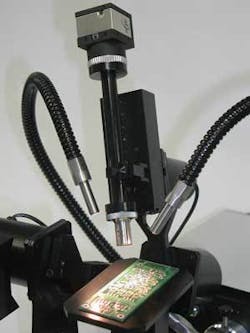Piezoelectric drives position cameras
Andrew Wilson, Editor, [email protected]
In 1880, Pierre and Jacques Curie showed that an electric potential could be generated by compressing a quartz crystal. One year later, they demonstrated that by applying an electric potential across such a crystal deformation occurs. Although this discovery did not find commercial applications until World War I, when it was used in sonar systems, the piezoelectric effect now finds many uses, most recently in nanopositioning systems for precise motion control in vision applications. In the development of its camera-shake-correction mechanism, for example, Konica Minolta (Tokyo, Japan; www.konicaminolta.com) uses the output of an angular velocity sensor to drive a CCD baseboard mounted on anx-y stage driven by a piezoelectric linear actuator that is perpendicular to the optical axis.
The technology is also being used in optical zoom and autofocus mechanisms. Most recently, New Scale Technologies (NST; Victor, NY, USA; www.newscaletech.com) announced a 2.4 × 2.4 × 6.5-mm linear motor based on the piezoelectric effect just for this purpose (seeVision Systems Design, April 2006, p. 24).
“Although currently available piezoelectric positioning systems achieve very high accuracy and repeatability,” says Valentin Zhelyaskov, vice president of DTI-NanoTech (Sarasota, FL, USA; www.dti-nanotech.com), “many piezoelectric translators (PZTs) used for nanopositioning have a typically limited travel range from 5 to 200 µm. By comparison, stages that use alternative motorized systems, such as dc or stepper motors, offer extended travel ranges but provide poor resolution (for example, 0.1 µm). Clearly this makes them inadequate for nanopositioning applications such as those used in semiconductor inspection systems, where a stage may need to be positioned with nanometer accuracy.”
To overcome these limitations, companies such as Physik Instrumente (PI; Karlsruhe, Germany; www.physikinstrumente.com) and DTI-Nanotech have developed patented piezoelectric nanopositioning linear translation stages with integrated optical encoders capable of nanometer accuracy and repeatability and 100-mm travel. PI’s RodDrives, for example, are designed to replace rotary motor/leadscrew assemblies or magnetic linear drives in micropositioning systems. Each drive consists of a rod preloaded by piezolinear motors from two sides. By coupling either the rod or the motor block to a moving platform, the integrated P-664 piezomotors provide accelerations up to 5 g, velocities of 400 mm/s, and minimum incremental motion to 0.05 µm.
To control PI’s drives, conventional servocontrollers are offered by several companies. These include Galil (Rocklin, CA, USA; www.galilmc.com), National Instruments (Austin, TX, USA; www.ni.com), and DeltaTau (Chatsworth, CA, USA; www.deltatau.com), all of which provide special software options to control piezolinear motors.
Like PI, DTI-NanoTech also supplies C/C++ and NI LabView support in the form of DLLs for its NTS NanoDirect Series of piezoelectric translation stages. With a 100-mm travel distance, velocity of up to 500 µm/s, and a closed-loop accuracy of 50 nm, the NTS stage converts the motion of a patented rotary piezoelectric motor into linear motion. Using a shaft-mounted 10,000-counts/revolution optical encoder enables the piezoelectric motor to be used in either continuous or stepper mode, therefore providing angular step positioning of 5 µrads to continuous motion at linear speeds to 500 µm/s.
To control the motor, DTI-NanoTech has designed the Nano-Direct DSP-based controller that can be supplied in one-, two-, or three-channel configurations. “This controller provides the link between the NTS stage and the host PC’s Windows XP-based operating system. “In applications such as semiconductor inspection,” says Zhelyaskov, “one, two, or three such drives can be configured to form a linearx-y or classical x-y-z positioning system.”
Combining three high-precision stages has led to the development of a new class of rotary stage (DTI Model PRS-1) with zero backlash and an angular linear motorized nanopositioning system, RoboMate. The desktop-sized combined rotational and linear motorized nanopositioning system allows a camera or probe to be positioned at variable angles with respect to the object under test.
“Using the RoboMate coupled with a camera is especially important in semiconductor applications, since the captured image is always fixed on a specific point on the die or wafer while its angle of incidence can be varied. This allows images of die bonds to be viewed from different angles so that manufacturers can check whether such bonds have, for example, a consistent shape,” Zhelyaskov says.

